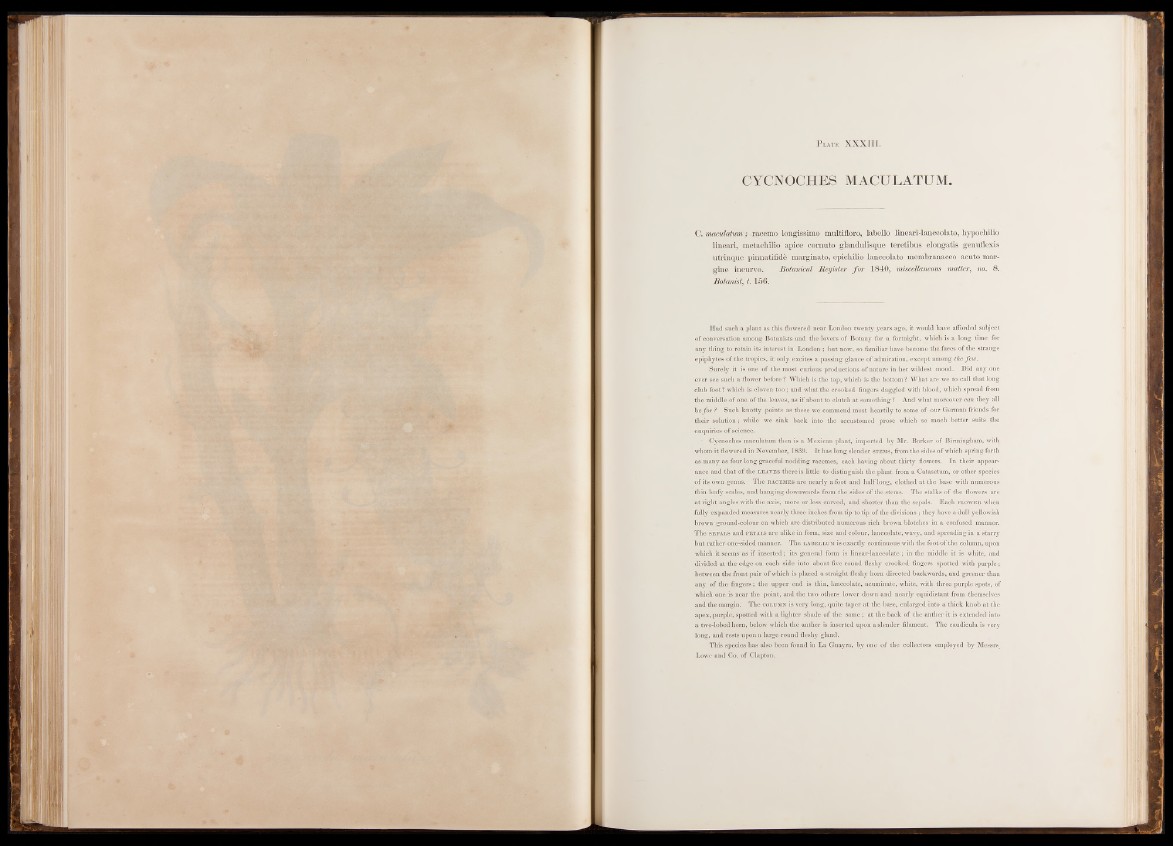
P late XXXIII.
CYCNOCHES MACULATUM.
C. maculatum; racemo longissimo multifloro, labello lineari-lanceolato, hypochilio
lineari, metachilio apice cornuto glandulisque teretibus elongatis genuflexis
utrinque pinnatifidb marginato, epichilio lanceolate membranaceo acute mar-
gine incurvo. Botanical Register fo r 1840, miscellaneous matter, no. 8.
Botanist, t. 156.
Had such a plant as this flowered near London twenty years ago, it would have afforded subject
of conversation among Botanists and the lovers of Botany for a fortnight, which is a long time for
any thing to retain its interest in London ; but now, so familiar have become the faces of the strange
epiphytes of the tropics, it only excites a passing glance of admiration, except among the few.
Surely it is one of the most curious productions of nature in her wildest mood. Did any one
ever see such a flower before ? Which is the top, which is the bottom 1 What are we to call that long
club foot? which is cloven too ; and what the crooked fingers with blood, which spread from
the middle of one of the leaves, as if about to clutch at something ? And what moreover can they all
be for ? Such knotty points as these we commend most heartily to some of our German friends for
their solution; while we sink back into the accustomed prose which so much better suits the
enquiries of science.
• Cycnoches maculatum then is a Mexican plant, imported by Mr. Barker of Birmingham, with
whom it flowered in November, 1839. It has long slender stems, from the sides of which spring forth
as -many as four long graceful nodding racemes, each having about thirty flowers. In their appearance
and that of the leaves there is little to distinguish the plant from a Catasetum, or other species
of its own genus. The racemes are nearly afoot and half long, clothed at the base with numerous
thin leafy scales, and hanging downwards from the sides of the stems. The stalks of the flowers are
at riglu ingles with the axis, more or less curved, and shorter than the sepals. Each flower when
fully expanded measures nearly three inches from tip to tip of the divisions ; they have a dull yellowish
brown ground-colour on which are distributed numerous rich brown blotches in a confused manner.
The sepals and petals are alike in form, size and colour, lanceolate, wavy, and spreading in a starry
but rather one-sided manner. The labellum is exactly continuous with the foot of the column, upon
which it seems as if inserted; its general form is linear-lanceolate; in the middle it is white, and
divided at the edge on each side into about five round fleshy crocked fingers spotted with purple;
between the front pair of which is placed a straight fleshy horn directed backwards, and greener than
any of the fingers; the upper end is thin, lanceolate, acuminate, white, with three purple spots, of
which one is near the point, and the two others lower down and nearly equidistant from themselves
and the margin. The column is very long, quite taper at the base, enlarged into a thick knob at the
apex, purple, spotted with a lighter shade of the same ; at the back of the anther it is extended into
a two-lobed horn, below which the anther is inserted upon a slender filament. The caudicula is very
long, and rests upon a large round fleshy gland.
This species has also been found in La Guayra, by one of the collectors employed by Messrs.
Lowe and Co., of Clapton.